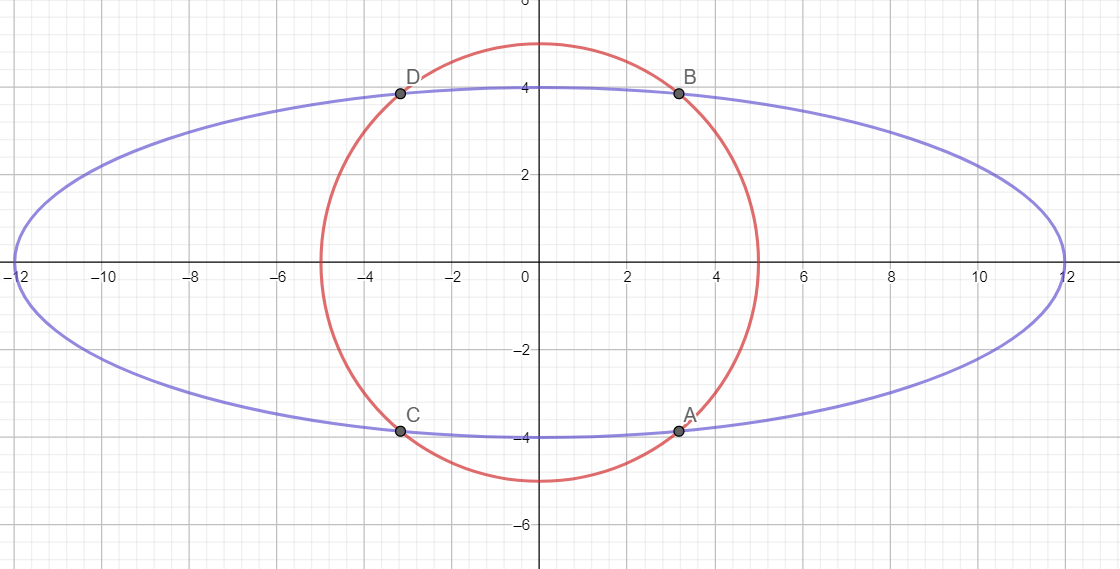
If $A=\left\{ \left( x,y \right):{{x}^{2}}+{{y}^{2}}=25 \right\}$ and $B=\left\{ \left( x,y \right):{{x}^{2}}+9{{y}^{2}}=144 \right\}$, then $A\bigcap B$ contains
[a] one point
[b] three points
[c] two points
[d] four points.
Answer
599.4k+ views
Hint: Assume (x,y) is in both sets A and B. Hence using the definitions of sets A and B form two equations in x and y. Solve for x and y. The number of solutions of the system is the number of points in $A\bigcap B$. Hence find the number of points in $A\bigcap B$. Alternatively, plot the two equations on a graph paper. The number of points of intersection of both curves gives the number of points in the intersection of sets A and B.
Complete step-by-step solution -
Let (x,y) be an element in both A and B.
Since (x,y) is in A, we have
${{x}^{2}}+{{y}^{2}}=25\text{ (i)}$
Also, since (x,y) is in B, we have
${{x}^{2}}+9{{y}^{2}}=144\text{ (ii)}$
Subtracting equation (i) from equation (ii), we get
$\begin{align}
& 9{{y}^{2}}-{{y}^{2}}=144-25 \\
& \Rightarrow 8{{y}^{2}}=119 \\
\end{align}$
Dividing both sides by 8, we get
${{y}^{2}}=\dfrac{119}{8}$
Subtracting $\dfrac{119}{8}$ from both sides, we get
${{y}^{2}}-\dfrac{119}{8}=0$
Writing the above expression in ${{a}^{2}}-{{b}^{2}}$ form, we get
${{y}^{2}}-{{\left( \sqrt{\dfrac{119}{8}} \right)}^{2}}=0$
We know that $\left( {{a}^{2}}-{{b}^{2}} \right)=\left( a+b \right)\left( a-b \right)$
Using the above formula, we get
$\left( y+\sqrt{\dfrac{119}{8}} \right)\left( y-\sqrt{\dfrac{119}{8}} \right)=0$
Using zero product property, we have
$y+\sqrt{\dfrac{119}{8}}=0$ or $y-\sqrt{\dfrac{119}{8}}=0$
Hence $y=-\sqrt{\dfrac{119}{8}}$ or $y=\sqrt{\dfrac{119}{8}}$.
Also. We have
${{x}^{2}}+{{y}^{2}}=25$
Substituting the value of ${{y}^{2}}$, we get
${{x}^{2}}+\dfrac{119}{8}=25$
Subtracting $\dfrac{119}{8}$ from both sides, we get
${{x}^{2}}=25-\dfrac{119}{8}=\dfrac{200-119}{8}=\dfrac{81}{8}$
Subtracting $\dfrac{81}{8}$ from both sides, we get
${{x}^{2}}-\dfrac{81}{8}=0$
Writing the above expression in ${{a}^{2}}-{{b}^{2}}$ form, we get
${{x}^{2}}-{{\left( \sqrt{\dfrac{81}{8}} \right)}^{2}}=0$
We know that $\left( {{a}^{2}}-{{b}^{2}} \right)=\left( a+b \right)\left( a-b \right)$
Using the above formula, we get
$\left( x+\sqrt{\dfrac{81}{8}} \right)\left( x-\sqrt{\dfrac{81}{8}} \right)=0$
Using zero product property, we have
$x+\sqrt{\dfrac{81}{8}}=0$ or $x-\sqrt{\dfrac{81}{8}}=0$
Hence $x=-\sqrt{\dfrac{81}{8}}$ or $x=\sqrt{\dfrac{81}{8}}$.
Hence the solutions are $\left( \sqrt{\dfrac{81}{8}},\sqrt{\dfrac{119}{8}} \right),\left( -\sqrt{\dfrac{81}{8}},\sqrt{\dfrac{119}{8}} \right),\left( \sqrt{\dfrac{81}{8}},-\sqrt{\dfrac{119}{8}} \right)$ and $\left( -\sqrt{\dfrac{81}{8}},-\sqrt{\dfrac{119}{8}} \right)$.
Hence there are four points in $A\bigcap B$
Hence option [d] is correct.
Note: Alternatively, we have
${{x}^{2}}+{{y}^{2}}=25$ is an equation of a circle with centre at (0,0) and radius = 5
And \[{{x}^{2}}+9{{y}^{2}}=144\] is an equation of an ellipse with centre at (0,0), major axis length as 24 and minor axis length as 8. The major axis is along the x-axis, and the minor axis is along the y-axis.
Keeping all these points in mind, we plot the curves, as shown below.

As is evident from the graph, there are four points of intersection. Hence the cardinality of $A\bigcap B$ is 4.
Complete step-by-step solution -
Let (x,y) be an element in both A and B.
Since (x,y) is in A, we have
${{x}^{2}}+{{y}^{2}}=25\text{ (i)}$
Also, since (x,y) is in B, we have
${{x}^{2}}+9{{y}^{2}}=144\text{ (ii)}$
Subtracting equation (i) from equation (ii), we get
$\begin{align}
& 9{{y}^{2}}-{{y}^{2}}=144-25 \\
& \Rightarrow 8{{y}^{2}}=119 \\
\end{align}$
Dividing both sides by 8, we get
${{y}^{2}}=\dfrac{119}{8}$
Subtracting $\dfrac{119}{8}$ from both sides, we get
${{y}^{2}}-\dfrac{119}{8}=0$
Writing the above expression in ${{a}^{2}}-{{b}^{2}}$ form, we get
${{y}^{2}}-{{\left( \sqrt{\dfrac{119}{8}} \right)}^{2}}=0$
We know that $\left( {{a}^{2}}-{{b}^{2}} \right)=\left( a+b \right)\left( a-b \right)$
Using the above formula, we get
$\left( y+\sqrt{\dfrac{119}{8}} \right)\left( y-\sqrt{\dfrac{119}{8}} \right)=0$
Using zero product property, we have
$y+\sqrt{\dfrac{119}{8}}=0$ or $y-\sqrt{\dfrac{119}{8}}=0$
Hence $y=-\sqrt{\dfrac{119}{8}}$ or $y=\sqrt{\dfrac{119}{8}}$.
Also. We have
${{x}^{2}}+{{y}^{2}}=25$
Substituting the value of ${{y}^{2}}$, we get
${{x}^{2}}+\dfrac{119}{8}=25$
Subtracting $\dfrac{119}{8}$ from both sides, we get
${{x}^{2}}=25-\dfrac{119}{8}=\dfrac{200-119}{8}=\dfrac{81}{8}$
Subtracting $\dfrac{81}{8}$ from both sides, we get
${{x}^{2}}-\dfrac{81}{8}=0$
Writing the above expression in ${{a}^{2}}-{{b}^{2}}$ form, we get
${{x}^{2}}-{{\left( \sqrt{\dfrac{81}{8}} \right)}^{2}}=0$
We know that $\left( {{a}^{2}}-{{b}^{2}} \right)=\left( a+b \right)\left( a-b \right)$
Using the above formula, we get
$\left( x+\sqrt{\dfrac{81}{8}} \right)\left( x-\sqrt{\dfrac{81}{8}} \right)=0$
Using zero product property, we have
$x+\sqrt{\dfrac{81}{8}}=0$ or $x-\sqrt{\dfrac{81}{8}}=0$
Hence $x=-\sqrt{\dfrac{81}{8}}$ or $x=\sqrt{\dfrac{81}{8}}$.
Hence the solutions are $\left( \sqrt{\dfrac{81}{8}},\sqrt{\dfrac{119}{8}} \right),\left( -\sqrt{\dfrac{81}{8}},\sqrt{\dfrac{119}{8}} \right),\left( \sqrt{\dfrac{81}{8}},-\sqrt{\dfrac{119}{8}} \right)$ and $\left( -\sqrt{\dfrac{81}{8}},-\sqrt{\dfrac{119}{8}} \right)$.
Hence there are four points in $A\bigcap B$
Hence option [d] is correct.
Note: Alternatively, we have
${{x}^{2}}+{{y}^{2}}=25$ is an equation of a circle with centre at (0,0) and radius = 5
And \[{{x}^{2}}+9{{y}^{2}}=144\] is an equation of an ellipse with centre at (0,0), major axis length as 24 and minor axis length as 8. The major axis is along the x-axis, and the minor axis is along the y-axis.
Keeping all these points in mind, we plot the curves, as shown below.

As is evident from the graph, there are four points of intersection. Hence the cardinality of $A\bigcap B$ is 4.
Recently Updated Pages
Why are manures considered better than fertilizers class 11 biology CBSE

Find the coordinates of the midpoint of the line segment class 11 maths CBSE

Distinguish between static friction limiting friction class 11 physics CBSE

The Chairman of the constituent Assembly was A Jawaharlal class 11 social science CBSE

The first National Commission on Labour NCL submitted class 11 social science CBSE

Number of all subshell of n + l 7 is A 4 B 5 C 6 D class 11 chemistry CBSE

Trending doubts
What is meant by exothermic and endothermic reactions class 11 chemistry CBSE

10 examples of friction in our daily life

One Metric ton is equal to kg A 10000 B 1000 C 100 class 11 physics CBSE

1 Quintal is equal to a 110 kg b 10 kg c 100kg d 1000 class 11 physics CBSE

Difference Between Prokaryotic Cells and Eukaryotic Cells

What are Quantum numbers Explain the quantum number class 11 chemistry CBSE




